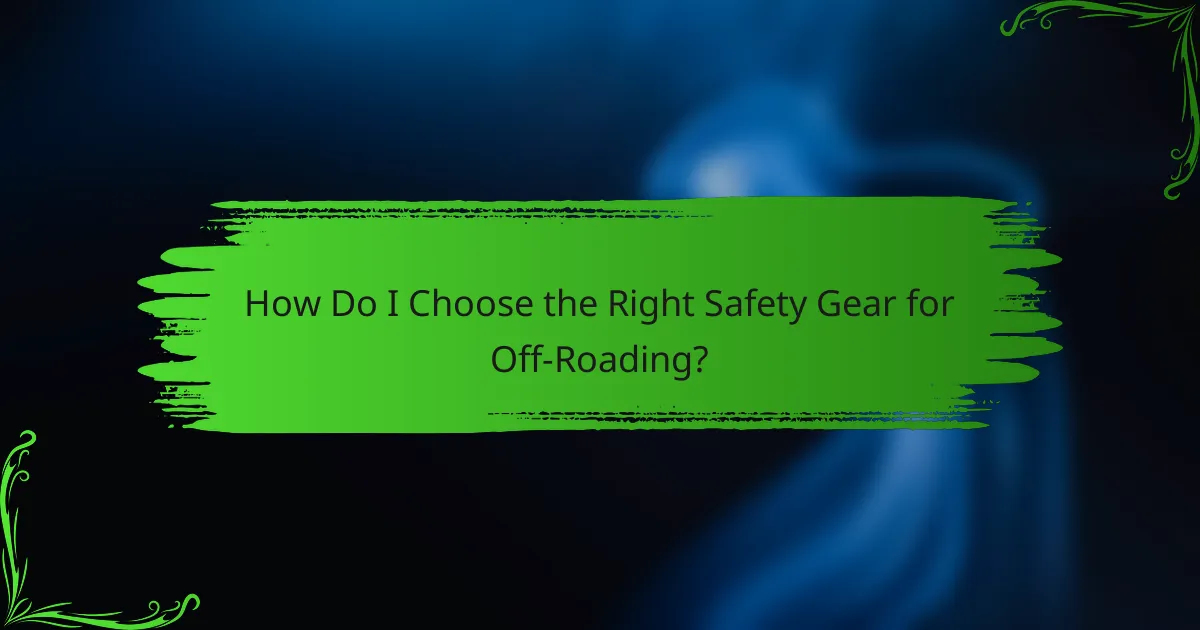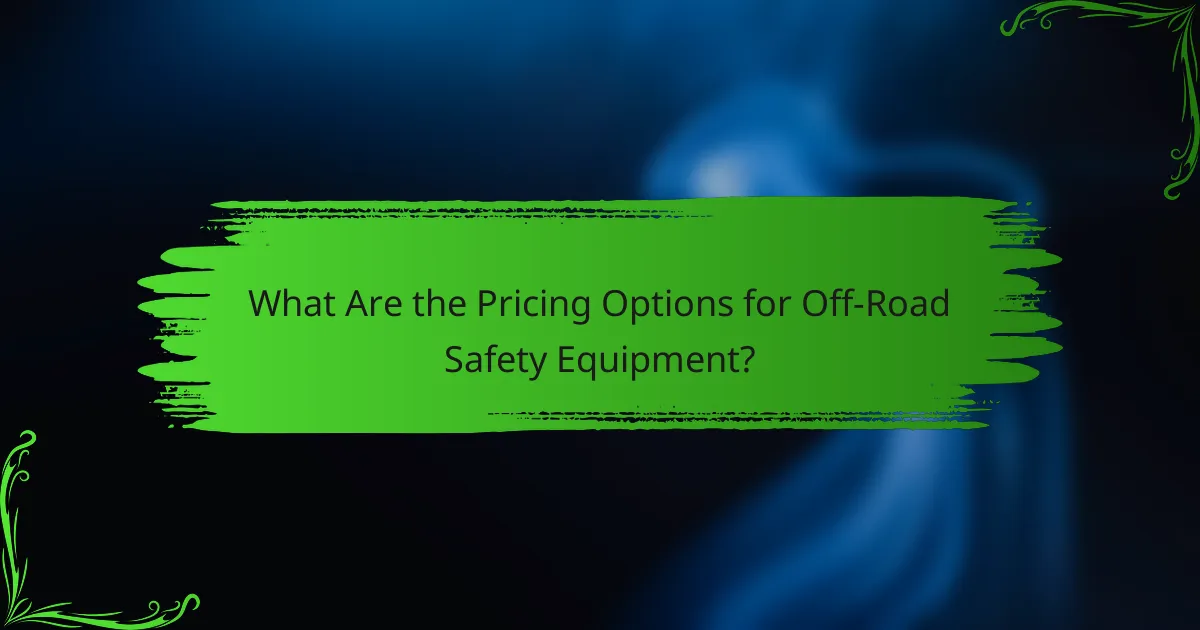When embarking on off-road adventures, having the right safety tech is crucial for a secure and enjoyable experience. Essential features such as GPS navigation systems, roll cage protection, and emergency communication devices can significantly enhance safety and support in challenging environments. Leading brands like Garmin, Rugged Radios, and Hella offer specialized tools designed to improve navigation, communication, and visibility, ensuring you are well-prepared for any rugged terrain you encounter.

What Are the Essential Safety Tech Features for Off-Road Adventures?
Essential safety tech features for off-road adventures include GPS navigation systems, roll cage protection, emergency communication devices, first aid kits, and fire extinguishers. These tools enhance safety, improve navigation, and provide critical support in emergencies while exploring rugged terrains.
GPS Navigation Systems
GPS navigation systems are crucial for off-road adventures, helping drivers track their location and navigate challenging terrains. Look for devices with offline maps and real-time tracking to ensure you remain oriented even in remote areas.
Consider models that offer features like topographic maps and waypoints, which can enhance your route planning. Popular options include handheld GPS units and smartphone apps designed for outdoor navigation.
Roll Cage Protection
Roll cage protection is vital for safeguarding occupants in the event of a rollover. A well-designed roll cage can absorb impact and prevent injuries, making it a must-have for off-road vehicles.
When selecting a vehicle, check for compliance with safety standards and ensure the roll cage is constructed from durable materials. Regular inspections and maintenance are essential to ensure its effectiveness during adventures.
Emergency Communication Devices
Emergency communication devices, such as satellite phones or two-way radios, are essential for staying connected in remote areas. These devices allow you to call for help when traditional cell service is unavailable.
Choose a device that fits your adventure’s needs, considering factors like battery life and range. Regularly test your communication devices to ensure they are functioning properly before heading out.
First Aid Kits
A well-stocked first aid kit is a critical component of off-road safety. It should include items like bandages, antiseptics, and pain relief medication to address common injuries that may occur during your adventures.
Regularly check and replenish your first aid kit, ensuring it meets the specific needs of your group. Consider including specialized items, such as snake bite kits or splints, depending on your destination.
Fire Extinguishers
Fire extinguishers are essential for preventing and controlling fires that may arise from vehicle malfunctions or accidents. Ensure your off-road vehicle is equipped with a suitable fire extinguisher that meets safety standards.
Familiarize yourself with the proper use of the extinguisher and check its pressure regularly. It’s advisable to carry a multi-purpose extinguisher rated for different types of fires, especially when traversing dry or wooded areas.

How Do I Choose the Right Safety Gear for Off-Roading?
Choosing the right safety gear for off-roading is essential for ensuring a safe and enjoyable adventure. Consider factors such as terrain type, vehicle compatibility, and your own experience level to select the most appropriate gear.
Consider Terrain Type
The terrain you plan to tackle significantly influences the safety gear you need. For rocky or uneven surfaces, durable helmets and protective clothing are essential, while sandy or muddy environments may require gear that offers better grip and water resistance. Always assess the specific challenges of the terrain, such as steep inclines or deep ruts, to determine the necessary protective equipment.
When exploring rugged trails, consider additional gear like knee and elbow pads to protect against falls. In contrast, if you are navigating through forested areas, lightweight, breathable clothing may be more suitable to avoid overheating while still providing protection.
Evaluate Vehicle Compatibility
Your choice of safety gear should align with your off-road vehicle’s specifications and capabilities. For example, if you’re using an ATV, ensure that your helmet meets the necessary safety standards for that vehicle type. Similarly, if you’re driving a 4×4, consider gear that offers protection against potential rollovers or impacts.
Check for compatibility with accessories like roll cages or harnesses, which can enhance safety. Always refer to the manufacturer’s guidelines for recommended gear to ensure optimal protection during your off-road adventures.
Assess User Experience Level
Your experience level plays a crucial role in determining the safety gear you should choose. Beginners may benefit from more comprehensive protective gear, such as full-face helmets and padded suits, to mitigate risks as they learn. In contrast, experienced off-roaders might opt for lighter gear that allows for greater mobility while still providing essential protection.
Consider taking a safety course or participating in guided off-road experiences to better understand the gear that suits your skill level. Always prioritize comfort and fit, as ill-fitting gear can hinder performance and safety.

What Are the Best Brands for Off-Road Safety Tech?
The best brands for off-road safety tech include Garmin, Rugged Radios, and Hella, each offering specialized products that enhance safety during off-road adventures. These brands provide essential tools for navigation, communication, and visibility, ensuring a safer experience in rugged terrains.
Garmin for GPS Devices
Garmin is renowned for its GPS devices that cater specifically to off-road enthusiasts. Their rugged handheld units and vehicle-mounted systems offer features like topographic maps, route planning, and real-time tracking, which are crucial for navigating unmarked trails.
When choosing a Garmin GPS, consider models with long battery life and water resistance, as these features are vital for off-road conditions. Popular options include the Garmin inReach series, which also provides satellite communication capabilities.
Rugged Radios for Communication
Rugged Radios specializes in communication systems designed for off-road environments, ensuring reliable contact between vehicles and crew members. Their products include two-way radios and intercom systems that withstand harsh conditions while providing clear audio quality.
For effective communication, select a system that offers features like noise cancellation and long-range capabilities. Popular models include the Rugged Radios R1 and R2, which are favored for their durability and ease of use in off-road settings.
Hella for Lighting Solutions
Hella is a leading brand for off-road lighting solutions, providing high-performance lights that enhance visibility during nighttime adventures. Their product range includes LED light bars, spotlights, and fog lights, designed to withstand tough conditions while illuminating the path ahead.
When selecting Hella lights, consider factors such as lumens output, beam pattern, and mounting options. Models like the Hella 500 series are popular for their brightness and reliability, making them a solid choice for off-road vehicles.

What Are the Pricing Options for Off-Road Safety Equipment?
Off-road safety equipment pricing varies widely based on features and quality, typically ranging from budget-friendly items to premium gear. Understanding these pricing tiers can help you select the right equipment for your adventures while ensuring safety and compliance with local regulations.
Budget-Friendly Choices
Budget-friendly off-road safety equipment usually costs between $50 and $150. Items in this range include basic first aid kits, reflective vests, and simple fire extinguishers. While these options are affordable, ensure they meet essential safety standards for off-road use.
When selecting budget gear, prioritize items that offer the most critical safety features. For example, a basic first aid kit should include bandages, antiseptic wipes, and a whistle for emergencies.
Mid-Range Options
Mid-range safety equipment typically falls between $150 and $500, providing a balance of quality and features. This category includes more comprehensive first aid kits, portable winches, and upgraded fire extinguishers. These products often come with better durability and additional functionalities.
Investing in mid-range gear can enhance your safety during off-road adventures. Look for items that include features like waterproof cases or multi-tool capabilities, which can be particularly useful in challenging environments.
Premium Safety Gear
Premium off-road safety equipment usually costs over $500 and includes high-end items such as advanced communication devices, specialized recovery gear, and professional-grade first aid kits. These products are designed for serious off-road enthusiasts and often feature superior materials and technology.
When opting for premium gear, consider the long-term benefits of durability and reliability. For instance, a high-quality recovery winch can be a lifesaver in tough situations, making it a worthwhile investment for frequent off-roaders.

How Can I Ensure My Off-Road Safety Tech Is Compatible?
To ensure your off-road safety tech is compatible, start by verifying that it meets the specifications of your vehicle and the terrain you’ll be navigating. Compatibility is crucial for effective performance and safety during your adventures.
Check Manufacturer Specifications
Review the manufacturer’s specifications for your off-road safety tech, including compatibility with your vehicle’s make and model. Look for details on power requirements, connectivity options, and any necessary software updates. This information is often found in the product manual or on the manufacturer’s website.
Ensure that the safety tech adheres to relevant industry standards, such as those set by the Society of Automotive Engineers (SAE) or other recognized bodies. This can help guarantee that the equipment is reliable and effective in off-road conditions.
Read User Reviews
User reviews can provide valuable insights into the real-world performance of off-road safety tech. Look for feedback on compatibility issues, ease of installation, and overall effectiveness in various terrains. Pay attention to reviews from users with similar vehicles and off-road experiences.
Consider both positive and negative reviews to get a balanced perspective. A product with a high number of favorable reviews may indicate strong compatibility, while consistent complaints about issues can be a red flag.
Consult with Experts
Consulting with experts, such as off-road vehicle technicians or experienced enthusiasts, can help you make informed decisions about safety tech compatibility. They can provide recommendations based on firsthand experience and knowledge of various products.
Joining off-road forums or local clubs can also connect you with individuals who have tested specific safety tech. Their insights can help you avoid common pitfalls and choose equipment that works well with your vehicle and intended off-road activities.
